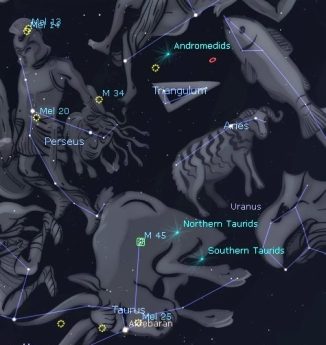This Week’s Sky at a Glance, 2024 Nov 2 – Nov 9
This Week’s Sky at a Glance, 2024 Nov 2 – Nov 9
I like to observe the sky at least once every day that I can, even if it is just for a few minutes. Often that entails observing the Sun through filtered telescopes and sketching the sunspots and prominences in my logbook. At night if I don’t feel like taking out a telescope I grab binoculars to perhaps see a comet or Mercury, or more often I tour the brighter star clusters. The mid-autumn constellations are home to many star clusters within easy reach of binoculars.
I usually start with the best open cluster, the Pleiades (M45) in the shoulder of Taurus the Bull, and focus the binos on its stars. The large V-shaped Hyades cluster, catalogued as Melotte 25, is nearby forming the face of the bull. It is anchored by orange Aldebaran at one corner, but that star is not really part of the cluster because it is less than half the distance to the others. The brightest star in nearby Perseus, Mirfak, is part of a group of stars called Melotte 20 that resembles a miniature version of the constellation Draco in binoculars. Perseus also holds the star cluster M34, which appears as a fuzzy patch in binos due to its distance. Between Perseus and Cassiopeia is a scenic Double Cluster (Melotte 13/14). Follow a string of stars from there to a large, dimmer cluster called Stock 2 or the Strongman Cluster.
This Week in the Solar System
Saturday’s sunrise is at 8:05 and sunset will occur at 6:09, giving 10 hours, 4 minutes of daylight. Next Saturday the Sun will rise at 7:15 and set at 5:00, giving 9 hours, 45 minutes of daylight. Set your clocks back this Saturday night and enjoy the extra hour of sleep and the extra hour of evening stargazing.
The slim crescent Moon is to the left of Mercury after sunset this Sunday and below Venus on Monday. It is at first quarter next Saturday. Mercury is low in the southwest this weekend, setting 40 minutes after sunset and extending that to 50 minutes by next weekend. Bright Venus slowly gains altitude as it continues to move eastward from the sun, setting around 7 pm midweek. Saturn is at its highest and best for observing around 8 pm, showing off its rings nearly edge-on. Jupiter rises before 7 pm midweek and telescope users might see its Red Spot near the middle of the planet around 8 pm Monday and 9:40 on Wednesday. Mars makes a scenic line with Castor and Pollux high overhead in the morning sky this weekend. We could see some extra meteors this week and next as the South and North Taurid meteor showers peak.
The Saint John Astronomy Club meets this Saturday at 7 pm in the Rockwood Park Interpretation Centre. Tune in to the Sunday Night Astronomy Show at 8 pm on the YouTube channel and Facebook page of Astronomy by the Bay.

